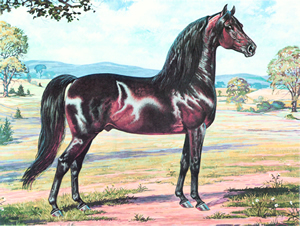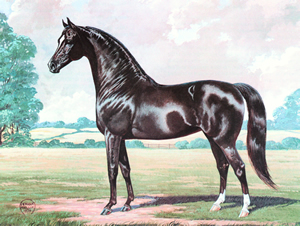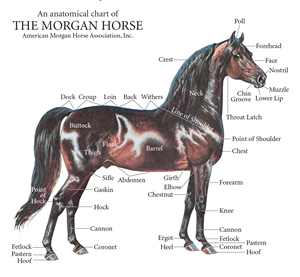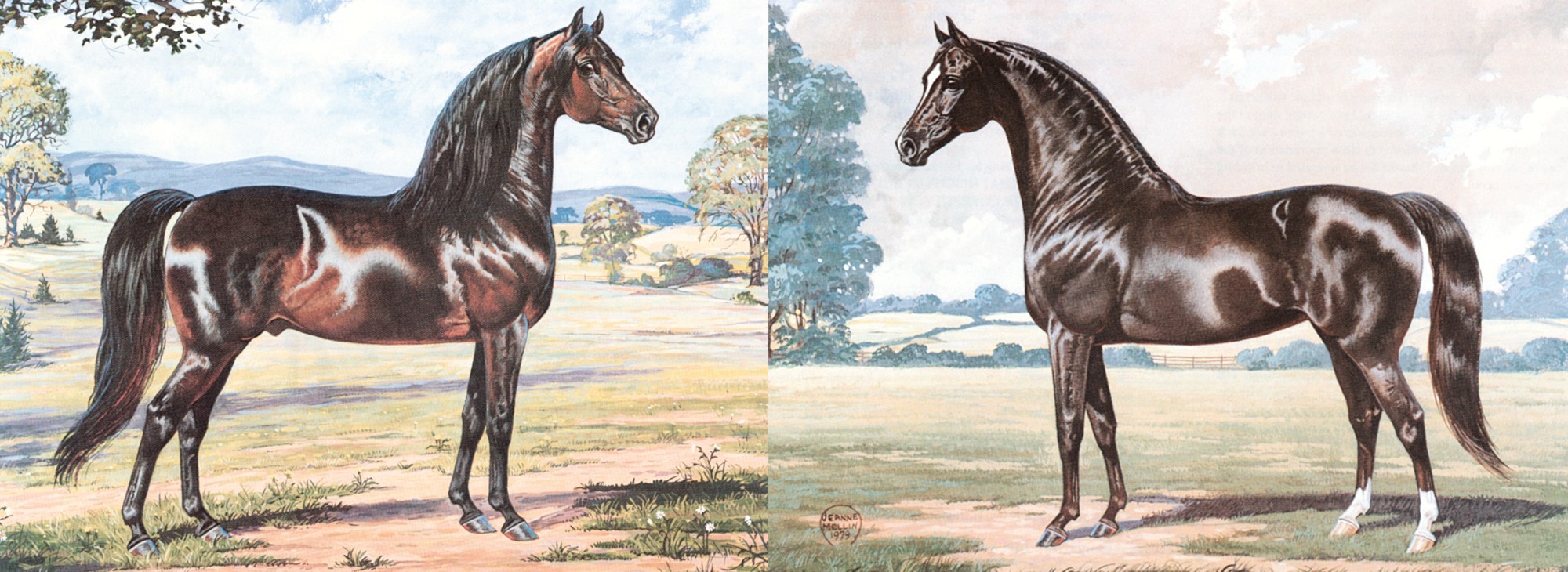Standard of Perfection
 |
| Morgan Stallion |
 |
| Morgan Mare |
 |
Correct Morgan type and conformation should be considered not only during In-Hand classes but also in performance classes where rules indicate that type and conformation are to be considered. The Standard is also used to evaluate Morgan type and conformation outside of the show ring.
-
Type is the ideal or standard of perfection for the breed. A Morgan is distinctive for its stamina and vigor, personality and eagerness and strong natural way of moving.
-
Conformation is the degree of perfection of the component parts and their relationship to each other.
-
The head should be expressive with broad forehead; large prominent eyes; with straight or slightly dished short face; firm fine lips; large nostrils and well-rounded jowls. The ears should be short and shapely, set rather wide apart and carried alertly. Mares may have a slightly longer ear.
-
The throatlatch is slightly deeper than other breeds and should be refined sufficiently to allow proper flexion at the poll and normal respiration.
-
The neck should come out on top of an extremely well-angulated shoulder with depth from top of withers to point of shoulder. It should be relatively fine in relation to sex. It should be slightly arched and should blend with the withers and back.The top line of the neck should be considerably longer than the bottom line. The stallion should have more crest than the mare or gelding. An animal gelded late in life may resemble the stallion more closely.
-
The withers should be well defined and extend into the back in proportion to the angulation of the shoulder.
-
The body should be compact with a short back, close coupling, broad loins, deep flank, well-sprung ribs, croup long and well muscled with tail attached high, carried gracefully and straight. A weak, low, or long back is a severe fault. The Morgan horse should not be higher at the croup than at the withers.
-
The stifle should be placed well forward and low in the flank area.
-
The legs should be straight and sound with short cannons, flat bone, and an appearance of over-all substance with refinement. The forearm should be relatively long in proportion to the cannon. The pasterns should have sufficient length and angulation to provide a light, springy step.
-
The structure of the rear legs is of extreme importance to the selection of a long-lasting equine athlete. Any sign of poor angulation of the hocks, sickle hocks or cow hocks must be considered a severe fault. Lack of proper flexion of the hock is cause for very close examination of the entire structure of the rear legs and should not be tolerated in breeding stock or show ring winners.
-
The feet should be in proportion to the size of the horse, round, open at heel, with concave sole and hoof of dense structure.
-
Viewed from the front, the chest should be well developed. The front legs should be perpendicular to the ground and closely attached to the body.
-
Viewed from the side, the top line represents a gentle curve from the poll to the back, giving the impression of the neck sitting on top of the withers rather than in front of them, continuing to a short, straight back and a relatively level croup rounding into a well muscled thigh. The tail should be attached high and carried well-arched. At maturity the croup should NOT be higher than the withers. The under line should be long and the body deep through the heart girth and flanks. The extreme angulation of the shoulder results in the arm being a little more vertical than in other breeds, placing the front legs slightly farther forward on the body. The front legs should be straight and perpendicular to the ground. The rear cannons should be perpendicular to the ground when points of hocks and buttocks are in the same vertical lines.
-
Viewed from the rear, the croup should be well rounded, thighs and gaskins well-muscled. Legs should be straight. The gaskin should be relatively long in relation to the cannon. The Morgan should portray good spring of rib and well-rounded buttocks. Slab-sided individuals should be faulted.
-
The height ranges from 14.1 to 15.2 hands, with some individuals under or over.
-
Horses must be serviceably sound-i.e. must not show evidence of lameness, broken wind or complete loss of sight in either eye.
-
Stallions two years old and over must have all the fully developed physical characteristics of a stallion. Mature stallions must be masculine in appearance. Mares must be feminine in appearance.
-
Coat or eye color shall have no bearing when judging Morgan horses.
-
Brands, including freeze brands, shall not be discriminated against in any class.
-
-
Other distinctive attributes of the Morgan horse are his presence and personality. These include:
-
Animation
-
Stamina
-
Vigor
-
Alertness
-
Adaptability
-
Attitude
-
Tractability
-
*The above descriptions have been adapted from "The Morgan Horse Judging Standards".
